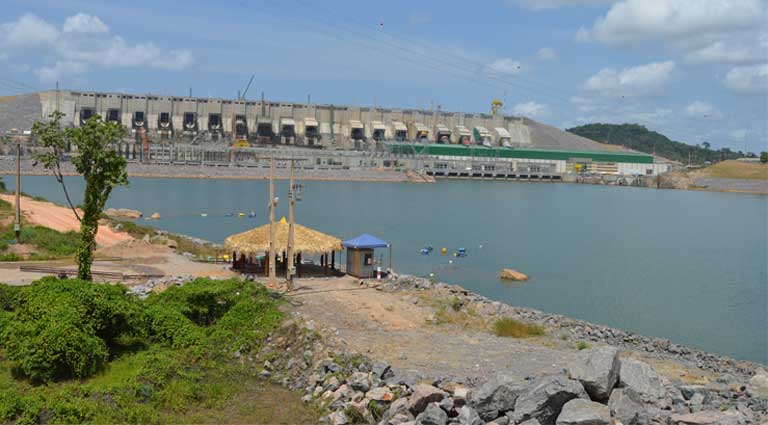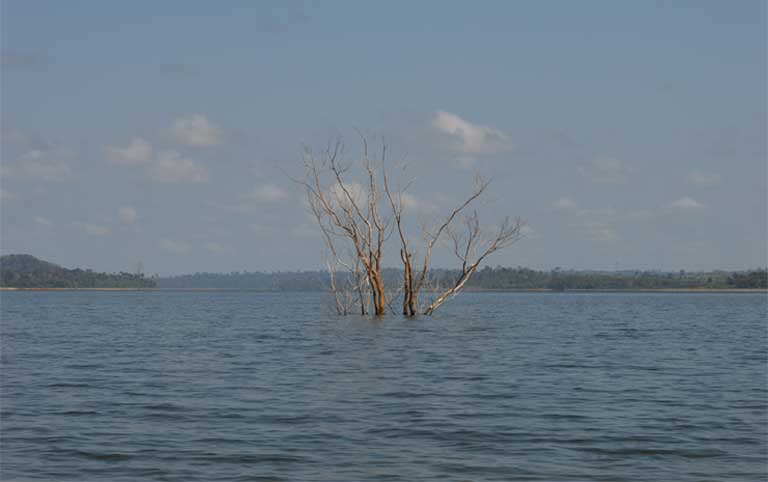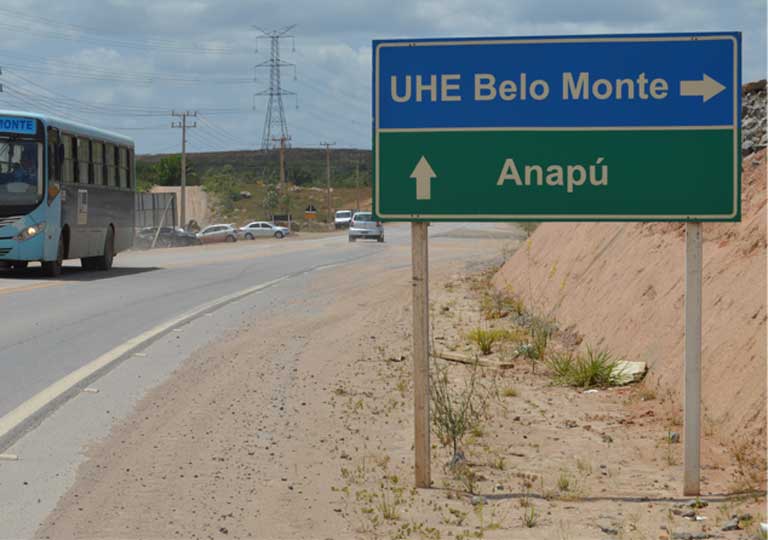- The Norte Energia Consortium — the group of companies that built the Belo Monte dam — signed an agreement with the Brazilian government in 2011 to pay US $1 billion to Altamira residents, including indigenous people, in compensation for the impacts of the dam. But traditional fisherfolk complain they have not been adequately compensated.
- The traditional fisherfolk say that the Amazon dam negatively impacted water quality and fish spawning in the Xingu River, and drastically reduced the area in which they could fish. Belo Monte also deprived them of the markets where they sold their fish — communities razed by the dam.
- Belo Monte’s construction also forced them to move from rural villages to a gritty urban resettlement community in the city of Altamira with few amenities. The fisherfolk also no longer live on the river, and so must commute to the waterway to pursue their fishing livelihood.
- Fisherfolk protests resulted in the creation of a new condition for Belo Monte’s operating license at the end of 2015. Norte Energia has been obliged to start a technical assistance project focused on improving fishing conditions on the Xingu River. IBAMA, Brazil’s environmental agency, is also studying the loss of income, along with the loss of identity and traditional practices to draft a compensation plan.

I do some fishing. I’ve been living off of fishing since I was old enough to understand. I’ve been fishing my whole life,” says Aureo da Silva Gomes. He is 33, short and intense, and his garage looks like a surreal volleyball court because of the fishing nets strung up from one side to the other for repairs.
He lives now in the Urban Resettlement Community of Jatobá in the city of Altamira, Brazil, near the site of the world’s fourth largest hydroelectric dam, known as Belo Monte.
“The fishing situation got worse because of this dam, both in terms of the fishing and the selling,” he says. “The city fell apart after the [construction company] left. We bring fish, but the prices are off, and there’s no one to sell to. The situation is really tough.”
Da Silva’s story is common here. There are five urban resettlements for people like him who were displaced from their homes and livelihoods along the Xingu River by the dam that went into operation earlier this year.
In a 2011 binding agreement with Brazil’s federal government, the Norte Energia Consortium — the group of companies that built the dam — agreed to pay US $1 billion to Altamira residents in compensation for the impacts of Belo Monte, but not much has been paid to date, says the Instituto SocioAmbiental (ISA), an NGO watchdog group. And it seems traditional fisherfolk like da Silva Gomes especially fell through the compensation cracks, though Norte Energia claims to be meeting its commitments.

It’s not surprising that the compensation situation is confused. Norte Energia´s Environmental Impact Study (RIMA) estimated that 16,420 people in the city of Altamira would be affected by the dam, plus another 2,822 from rural areas. The Movement for People Affected by Dams (MAB), however, puts the figure at roughly double: 40,000. The City of Altamira admits to not having a count of residents in the resettlement communities. But it says there are 4,277 new houses, while the city´s planning department estimates five people per home, which would put the resettled population at 21,385.
Traditional fisherfolk face hard times
The Belo Monte dam’s impact on indigenous people who live along the Xingu River was one reason it received international attention — and criticism. But the area impacted by the dam was also home to traditional people who generally lived on communal land and supported themselves with small scale farming, fishing and hunting. Researchers have found that such sustainable practices tend to ensure Amazon forests are preserved better than compared to areas where human co-existence is excluded.
Instituto SocioAmbiental reports that non-indigenous people in the region date at least to the end of the 19th century, when rubber was first being tapped there. While some of those living a traditional lifestyle migrated from elsewhere in Brazil, others, like da Silva, come from families who have thrived here for generations.
Traditional peoples, like indigenous groups, are protected by the International Labor Organization´s convention 169, which requires free, previous and informed consent when projects like the Belo Monte dam are slated for their lands. Traditional groups, however, are not specifically protected by Brazil´s constitution the way that first nations or Quilombolas, communities established by escaped slaves, are.
“During the summer, the good season, I was able to get 100 kilos [220 pounds] of fish a week, before the dam arrived. I don´t get that any more,” da Silva Gomes laments as he sits on a bench in his kitchen in Jatobá, the urban resettlement community (RUC). Before the dam came, he owned three homes near the Xingu River in Altamira that he rented to supplement his fishing income, while he resided primarily in an area along the river called Vasão dos Padres.
His urban rental properties in Altamira were also razed as a result of the dam, and da Silva was displaced from Vasão dos Padres to a labyrinthine urban neighborhood roughly four kilometers (2.5 miles) from the river. There are few amenities where he lives now: the streets have no signs marking their names; there is no public transportation; and there are few, if any, trees.

“We used to pay almost nothing for shipping, transportation, to come and go [when we lived by the river]. When I was transferred to this area, what happened? Now I spend 100 Reals a week to go, bring my [fishing nets and other equipment] to the river, and come back. This 100 Reals, I didn´t have as an expense [before]. Now we’re losing our boats. I myself lost a boat that cost around 12,000 Reals because I didn’t have the money, 200 Reals, to bring it back and forth [to the city] every week. So I left it at the river’s edge, and it was stolen.”
There is little work for him in urban Altamira, either. Da Silva Gomes says that he has some skills, that he can “work figures,“ but “I don’t have much education, [and] even if I did have, I wouldn’t get a job. I’ve got nieces and nephews who finished school, and they can’t find jobs. They’re washing dishes.”
As a result, he and his colleagues remain committed to fishing, even though they face serious challenges. Belo Monte’s construction shattered social networks; it broke bonds of kinship, friendship and business: “The dam arrived, and it got rid of the clientele in the area where we sold fish,” he says —communities that had long served as fish markets were destroyed to make way for the reservoir.
At the same time, the dam’s environmental impacts reduced the daily catch. Water quality was impaired and spawning areas ruined. Fish kills have grown common. More than sixteen tons of fish were killed when the dam initially began operating, bringing down an 8 million Real fine on the consortium.
So the traditional fisherfolk struggle on — uprooted from their homes and livelihoods, transplanted from a rural river setting to gritty Altamira.

Forgotten traditional people
These impacts, says ISA attorney Carolina Reis, were overlooked from the project’s outset by the Brazilian government and by Norte Energia. “The fisherfolk, who as a traditional group, live in this [intimate] relationship with the river, who have a cultural and economic way of life that is tied to the river, were made invisible during Belo Monte’s licensing process. The impacts on fisherfolk, on fishing, how this would reflect on people’s lives, this wasn’t identified, measured or qualified before the licenses were issued so that a compensation program could be created for these families.”
Complicating matters, she says, is the fact that IBAMA, Brazil’s environmental agency, relies on reports from Norte Energia to monitor living conditions in the Belo Monte impacted area.
The Federal Public Ministry (MPF) in Altamira is due to complete a study by the end of the year to determine the extent of the impacts on traditional fisherfolk, reveals Higor Pessoa, a prosecutor with the office that focuses on environmental issues.
“The MPF has already collected evidence of the destruction of fishing areas that were traditionally used by fisherfolk before the Belo Monte dam,” Pessoa told Mongabay. “Due to the project, [those parts of the river] were suppressed [in their flow], or prohibited [for use,] or filled in. And so far, they haven’t been repaired, returned to their prior state.”
Both Pessoa and da Silva Gomes stress that the number and variety of fish in the river have been greatly reduced since the dam project began. Not only that, but the part of the river in which traditional fisherfolk were allowed to fish has been severely restricted, causing it to become overcrowded and overfished, da Silva Gomes explains. “The space that they gave us, that the Belo Monte dam gave us, is really small. Upriver are indigenous areas where no one can fish. Downriver are indigenous areas and the dam. I think we have 300-500 fisherfolk [crammed] in this area.”
The overcrowding leads to conflict. “Folks from the region, sometimes from Vitoria de Xingu, end up even stealing fish from the indigenous areas,” da Silva Gomes states. “There have been cases of broken boats, of arrested fishermen because [traditional fisherfolk now] tend to risk going into the indigenous areas, where not allowed, but they go because [they] need the fish.” ISA reports that fisherfolk from other parts of the river also enter these local fishing spots, which creates another layer of conflict.
Reis told Mongabay that fisherfolk resistance resulted in the government’s creation of a new condition for Belo Monte’s operating license at the end of 2015. “IBAMA obligated Norte Energia… to start a technical assistance project focused on fishing for at least three years throughout the entire area that experienced alterations [from the dam], whether as a result of the [new] reservoir or reduced water flow [in the river’s main stream which was largely bypassed by Belo Monte’s construction].”

Reis hopes that a compensation system that recognizes not just the loss of income by traditional fisherfolk, but also the loss of identity and traditional practices will be created.
“The traditional knowledge of the Xingu River’s fisherfolk, is intimately tied to the landscape,” Reis explains. “There is a risk of losing the transfer of knowledge of these traditional fishing methods, of all this valuable non-material knowledge that has always been passed down from one generation to the next — from grandfathers to fathers to sons — because the fisherfolk are farther from the river now. And the ones who are on the river find a river that has changed and [they’re facing] a lot of difficulty fishing the way they did before.”
Some, like Valda Josefalda Silva da Conceição, are refusing to give up on their former homes. She lived on an island near the river village of Vasão dos Padres. “I was born and grew up on the river’s edge. I’m a fisherwoman,” she explains. Silva da Conceição is heavy set with dark skin, her t-shirt dirty from house work. Her young daughter climbs onto her lap during the interview. She describes the humble origins that she and her husband shared on the banks of the Xingu River and tells of their connection to the local environment.
“My husband doesn’t know how to read. He just knows how to fish,” she says.

The entire family was displaced by Belo Monte — Silva da Conceição, her husband, daughter, niece and her niece´s baby. Now they live in Jatobá, the same resettlement community where da Silva Gomes resides. There she raises chickens and grows herbs and a few vegetables on the narrow strip of land between her house and the fence around it. Her dogs, while they may be small, help keep people from stealing the chickens and other valuables. Still, Silva da Conceição won´t leave her home unattended for fear of thieves.
Norte Energia offered her 3,200 Reals (approximately US $1,000) in compensation for their home on the island that she says the company burned. She told Mongabay that the company also offered her a place to fish, but she refused, holding out for a return to her island property. Norte Energia didn’t respond to Mongabay’s request for comment regarding Silva da Conceição´s case.
Antonia Melo is one of Silva da Conceição´s most important allies. Melo heads up Xingu Vivo, an NGO based in Altamira that focuses on the people and environment of the Xingu River. She is one of the area’s leading dam activists, and was offered personal security because of the threats she received when the Belo Monte dam construction conflict was hot.
“We’re [supporting] the riverside families who suffered an attempt on their lives by Norte Energia and Belo Monte,” Melo told Mongabay. “They were expelled from their homes and their houses burned. They came to the city without knowing [where they were being taken], many without compensation, and they’re dealing with hunger.”
Melo cites Silva da Conceição and her relatives as just one example of the many families trying to return to the river. The Federal Public Ministry, the Public Defender’s Office and IBAMA, are working with Xingu Vivo on this, she says. “There’s a process to help people return to the islands to try to rebuild their lifestyles, which is going to be really tough without the land that makes up their floor.”
This is the crux for Silva da Conceição. Eight months ago she filed a lawsuit to be able to return to her island home. The case hasn’t been resolved yet, but she’s set on her goal: “I want my land back.”

